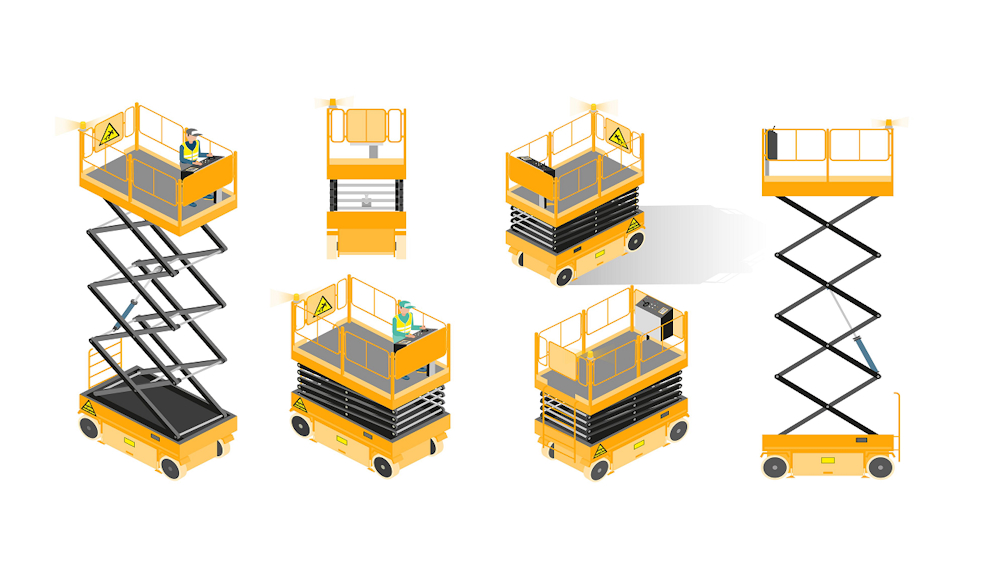Scissor Lifts Selection Guide: Exploring Types, Features, and Applications

A scissor lift is a must-have piece of equipment for every construction company. This specialised machine has crucial parts that work together to help workers seamlessly lift heavy loads to high elevations. They include a platform base, scissor legs and a power source, which can be a cylinder or a motor.
The construction lift operates using a linked, folding support mechanism that extends and retracts in a scissor-like motion. When the equipment is in operation mode, it vertically stretches its scissor arms lifting the load to the desired height.
If you plan to purchase a scissor lift, it's best to choose one that fits your site's needs. Choosing the wrong one can cause damage to your workplace and, even worse, severe injuries. For safety and efficiency, keep reading this article and understand the different types of scissors and their applications.
Scissor Lift Selection - Everything You Need to Know
Types of Scissor Lifts
Hydraulic Scissor Lift
A hydraulic scissor lift utilises a hydraulic system to operate. Hand-operated equipment changes the hydraulic oil's pressure, enabling it to lift loads up and down a building. While the hydraulic scissor lift is easy to operate, it is much slower, especially during cold seasons. The hydraulic oil becomes viscous, making it difficult to operate in such seasons.
Electric Scissor Lifts
Unlike hydraulic scissor lifts, electric scissor lifts can be operated at any season as long as you have a convenient power source. They are also suitable for anyone who prefers noiseless and emission-free lifts. With the help of electric motors, loads are lifted up and down the platform without any noise disturbances and emissions. If you have many indoor operations, the electric scissor lift is your best choice.
Rough Terrain Scissor Lifts
Rough terrain scissor lifts are outdoor-operated equipment designed to lift bulk loads on rough terrain. Due to their heavy-duty tires and high weight capacity, these scissor lifts are convenient for work sites that lift hefty loads on uneven terrain and slopes. They are also safe and convenient to use during harsh weather conditions.
Pneumatic Scissor Lifts
Pneumatic scissor lifts only require air pressure to lift and drop loads at a work site. However, since they operate on air alone, they are mostly convenient for indoor facilities. Moreover, pneumatic scissor lifts do not emit gases, making them the most environmentally friendly option compared to other conventional scissor lifts.
Scissor Lift Features and Specifications
Lifting Capacity
The amount of weight you intend to lift should determine the type of scissor lift you should have. If your daily operations require lifting high-weight capacity loads, choose a lift designed for hefty loads.
Platform Size
The platform size will depend on the number of people or type of quantity material you would need to lift. If you have many workers on your construction site, you might want to get a large-size platform.
Lift Height
Will you be in tight indoor spaces or at an outdoor job site? For tight areas and other indoor workplaces, a 19-foot scissor lift can work perfectly. For outdoor areas, a 40-foot scissor lift is desirable. However, if you have extensive jobs that require maximum lift height, opt for the 50-foot scissor lift.
Working Height
How high do you want to go when operating a scissor lift? There are a variety of heights to choose from, so you should be able to find a scissor lift that offers the right amount of vertical reach.
Platform Extensions
Scissor lift tables come equipped with a standard platform extension. The platforms can extend up to 3 feet. But if you have loads that need to be lifted higher than this, you can provide additional height by adding another platform to the existing one.
Mobility and Maneuverability
Mobility and manoeuvrability are critical when choosing a scissor lift table. If you are operating in tight indoor places, you need a scissor lift that can manoeuvre easily within those tight spaces. A narrow-width scissor lift is perfect for such workplaces.
Safety Features and Compliance
To ensure Elevating Work Platform safety, all scissor lift operators should adhere to these guidelines -
- Undergo training before operating a scissor lift.
- Use scissor lift for their designed purpose. For example, indoor scissor lifts should never be used for outdoor operations.
- Ensure the scissor lift has guardrails to prevent falls.
What are the Applications of Scissor Lifts?
Construction and Buildings Maintenance
Scissor lifts are used in construction and building maintenance operations that require working high in the air, like pouring concrete, hanging banners or changing signs.
Warehousing and Material Handling
Warehouses with high racks and narrow spaces require a scissor lift for loading and retrieving pallets.
Manufacturing and Assembly
Scissor lifts help assemble large machinery, install components at elevated heights and conduct inspections.
Retail and Facility Management
Retailers rely on scissor lifts to stack up products on high shelves, thus minimising space wastage.
Film Production and Entertainment
Scissor lifts help film producers create dynamic shots from elevated angles, capturing unique perspectives from sweeping movements.
Conclusion
Scissor lifts have proven to be indispensable tools across various industries. Their versatility, safety features, and ease of operation make them a must-have equipment for construction, film production, maintenance, and more. With their ability to provide access to elevated workspaces and improve efficiency, scissor lifts continue to enhance productivity and safety in different fields.

























